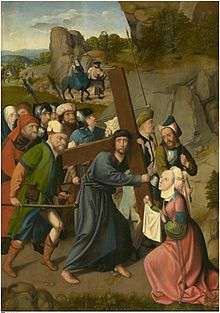Master of Hoogstraeten

The Master of Hoogstraeten (c.1475 – c.1530) is the notname given to a Flemish painter active in Antwerp in the early 16th century. He painted mainly religious paintings and is considered a member of the Antwerp Mannerists.[1]
Identification
The identity of the Master is not known, although attempts have been made to link him with Passchier van der Mersch, a Flemish painter who was a pupil of the leading Antwerp painter Hans Memling. Because of a clear Dutch influence on his work, it has also been surmised that the Master was in fact originally from the Northern Netherlands.[2]

The notname Master of Hoogstraeten was coined by the historian of Early Netherlandish art Max Jakob Friedländer after a set of seven panels each depicting one of the Sorrows of the Virgin that originally hung in the church of Saint Catharina in the town of Hoogstraten (now in the Antwerp province of Belgium). The panels believed to have been painted in 1505 remained in the church until the beginning of the 19th century and are now in the Royal Museum of Fine Arts Antwerp.[3]
The Master may have been a pupil of Hans Memling himself, but his work also shows the influence of Flemish artists like Gerard David (1460 – 1523) and Hugo van der Goes (1440 – 1482). A painting of Madonna and Child with Saints Catherine and Barbara, now in the Uffizi Gallery, was once attributed to Hugo van der Goes, but is now claimed to be a work of the Master of Hoogstraeten.[3]
Work
He is known for religious works.[4]

The Antwerp Mannerists typically depicted religious themes, which they interpreted generally in a more superficial manner than the Flemish artists of the previous century in favour of a more fluid form and an abundance of meticulously rendered details.[5] They also show a preference for a changing palette. Their compositions are typically shock-full with agitated figures in exotic, extravagant clothes. The compositions typically include architectural ruins. The architecture is initially Gothic but later Renaissance motifs become dominant.[6] Many of the panels or triptychs produced by the Antwerp Mannerists depicted scenes of the Nativity of Jesus, usually situated at night, the Adoration of the Magi and the Crucifixion.[5]
The theme of the Adoration of the Magi was in particular dear to them as it allowed the artists to give free rein to their preoccupation with ornament and the simulation and imitation of luxury products.[7]
Notes
- ↑ Meester van Hoogstraten at Museum Mayer van den Bergh (Dutch)
- ↑ Challis, Kate. "Master of Hoogstraeten." The Oxford Companion to Western Art. Ed. Hugh Brigstocke. Oxford Art Online. Oxford University Press. Web. 20 Aug. 2016
- 1 2 Master of Hoogstraeten at the Uffizi
- ↑ Master of Hoogstraeten at the Netherlands Institute for Art History (Dutch)
- 1 2 "H. Bex-Verschaeren" "Meester van de Antwerpse aanbidding", in: Openbaar Kunstbezit, 1965 (Dutch)
- ↑ 'De schilderkunst der Lage Landen: De Middeleeuwen en de zestiende eeuw', Amsterdam University Press, 2006, p. 172-175 (Dutch)
- ↑ Elizabeth A. H. Cleland, Grand Design: Pieter Coecke van Aelst and Renaissance Tapestry, Metropolitan Museum of Art, 6 October 2014
External links
 Media related to Master of Hoogstraeten at Wikimedia Commons
Media related to Master of Hoogstraeten at Wikimedia Commons